Floor & Decor Bundle
How Did Floor & Decor Rise to Flooring Industry Prominence?
Ever wondered how a single store in Atlanta transformed the flooring market? The Floor & Decor SWOT Analysis reveals a compelling story of strategic vision and market adaptation. From its humble beginnings in 2000, this company has redefined how consumers and professionals alike approach hard surface flooring. Let's explore the fascinating journey of the Floor & Decor company.
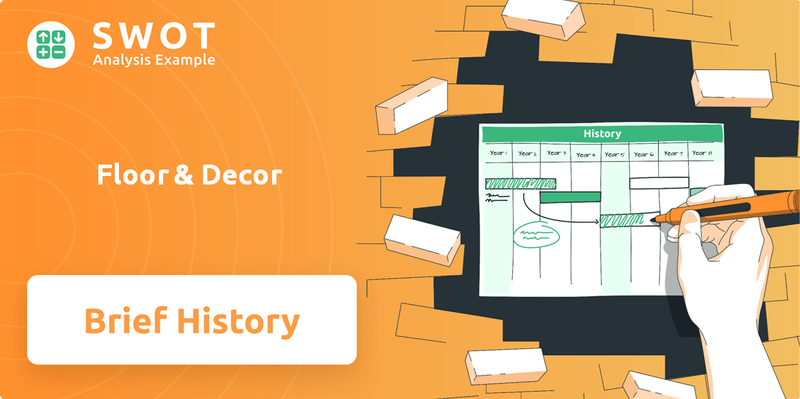
The Floor & Decor story is one of remarkable growth, driven by a keen understanding of market trends and consumer needs. Understanding the Floor and Decor history is crucial for investors and business strategists alike. This overview will explore the Floor & Decor origin, its evolution, and the milestones that have shaped its success, providing a comprehensive Floor & Decor timeline from its founding to its current position.
What is the Floor & Decor Founding Story?
The story of the Floor & Decor company began in 2000. It was founded by George Vincent West in Atlanta, Georgia. West's vision was driven by a personal need and a keen understanding of a gap in the market.
Frustrated with the limited options available for hard surface flooring, West saw an opportunity. He aimed to create a specialized retail experience. This would focus solely on an extensive selection of flooring materials.
The founding of the company marked the beginning of a new approach to flooring retail. It offered a wide variety of products in a warehouse-style setting.
The initial concept of the company was to provide a broad selection of hard surface flooring. This included tile, wood, laminate, and natural stone. It was offered alongside installation accessories, all at everyday low prices.
- The first store opened on the outskirts of Atlanta.
- The store was designed as a warehouse. It was stocked with a growing array of flooring choices.
- Early funding came from outside investors.
- By February 2003, private equity firms acquired the company. This provided capital for expansion.
Floor & Decor SWOT Analysis
- Complete SWOT Breakdown
- Fully Customizable
- Editable in Excel & Word
- Professional Formatting
- Investor-Ready Format
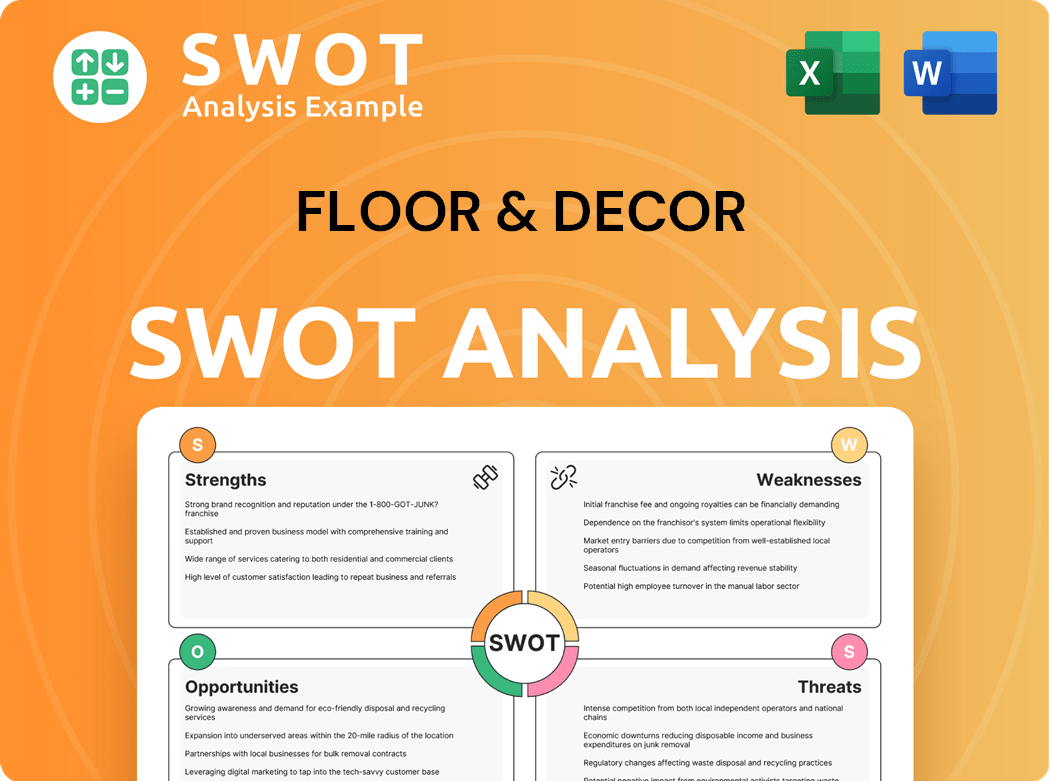
What Drove the Early Growth of Floor & Decor?
The early years of the Floor & Decor company were marked by rapid growth and strategic investments. Founded, the company quickly showed promise, leading to its acquisition by Saugatuck Capital and Najeti Ventures in February 2003. This early funding helped fuel the company's initial expansion, setting the stage for its future growth.
Following its founding, the company's potential was quickly recognized, leading to its acquisition by Saugatuck Capital and Najeti Ventures in February 2003. By early 2006, the company had expanded to 13 stores across the southern U.S. This early expansion phase focused on offering a wide range of flooring options, including hardwood, laminate, tile, and marble.
Despite the economic downturn, the company continued to grow its sales and increase its store count. This resilience attracted further investment, demonstrating the company's strong business model. In November 2010, private equity firms Ares Management and Freeman Spogli & Co. acquired the business, by which time it had expanded to 25 large-format stores.
A significant leadership change occurred in 2012 when Thomas Taylor, formerly of The Home Depot, joined as CEO. Under Taylor's guidance, the company accelerated its growth, implementing a strategic plan for significant store expansion. The company's revenue grew from $2.4 billion in 2020 to $4.5 billion in 2024.
The company significantly increased its digital presence during this period, enhancing its online sales and customer engagement. At the time of its IPO in 2017, the company operated 65 warehouse stores. By early 2025, the company had expanded to 254 warehouse stores and five small-format design studios across 38 states.
Floor & Decor PESTLE Analysis
- Covers All 6 PESTLE Categories
- No Research Needed – Save Hours of Work
- Built by Experts, Trusted by Consultants
- Instant Download, Ready to Use
- 100% Editable, Fully Customizable
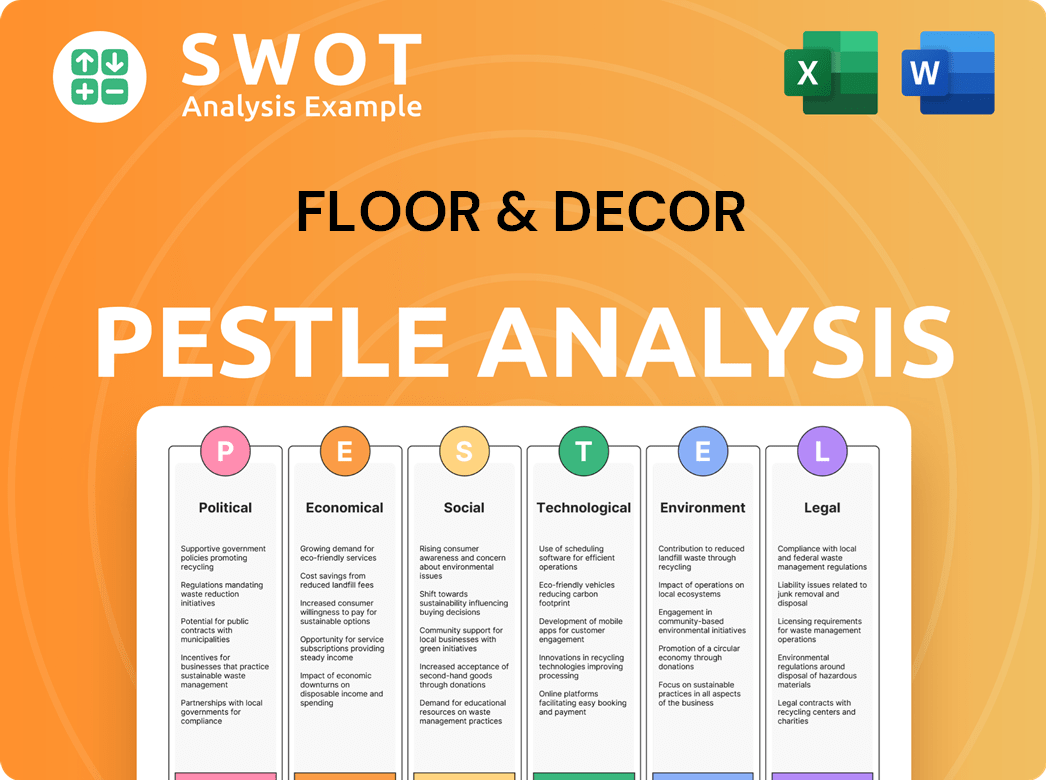
What are the key Milestones in Floor & Decor history?
The history of Floor & Decor, a prominent player in the flooring industry, is marked by significant milestones that have shaped its growth and market position. Understanding the Floor & Decor history provides insights into its strategic evolution and impact on the flooring market. The Floor & Decor company has expanded significantly since its inception, becoming a leading retailer in the home improvement sector.
| Year | Milestone |
|---|---|
| Early Years | Floor & Decor origin involved establishing a unique retail model focused on large-format stores and a wide product selection. |
| Expansion Phase | The company focused on rapid Floor & Decor company growth by opening new Floor & Decor store locations history across the United States. |
| Direct Sourcing | Floor & Decor implemented a direct sourcing model to offer competitive pricing and adapt to market trends. |
| 2024 | The U.S. became its largest single-country source, accounting for 28% of products sold, reducing reliance on Chinese production to 18%. |
| Ongoing | Continued investment in customer experience, particularly for Pro customers, and expansion of commercial surfaces business. |
Floor & Decor has been innovative in its approach to the retail market. A key innovation is its direct sourcing model, which allows the company to offer a broad and trend-right product assortment at competitive prices, with over 240 vendors in 26 countries.
This model enables Floor & Decor to quickly adapt to shifting design trends and introduce new products, maintaining a competitive edge. This approach supports the company's ability to offer a wide variety of flooring options.
The company’s focus on a 'warehouse-styled' store model with a vast in-stock selection, averaging 4,500 SKUs and 1.0 million square feet of flooring products per store, is a critical differentiator. This model provides customers with a comprehensive selection and immediate availability.
Floor & Decor has diversified its product sourcing to reduce reliance on any single country, enhancing its supply chain resilience. By 2024, the U.S. became its largest single-country source, accounting for 28% of products sold.
Investing in services tailored to professional customers has been a key area of innovation. This includes specialized services and support to meet the needs of contractors and other industry professionals.
Enhancing the 'connected customer' experience through digital platforms and in-store technology has been a strategic focus. This helps to improve customer engagement and streamline the shopping process.
Expanding the commercial surfaces business, which accounted for approximately 10% of revenue in 2024, is another innovation. This diversification helps to capture a larger share of the flooring market.
Despite its strengths, Floor & Decor has faced challenges, particularly from macroeconomic conditions. The post-pandemic period, characterized by interest rate increases, led to a decline in existing home sales, creating a challenging environment for the company. For more details, consider reading about the Growth Strategy of Floor & Decor.
High interest rates and inflation have negatively impacted the housing market and consumer spending, leading to declines in comparable store sales. Comparable store sales decreased by 0.8% in Q4 2024 and 1.8% in Q1 2025.
Operating profit declined from 9.3% in 2022 to 5.7% in 2024, reflecting operational deleverage in a softer demand environment. This decline indicates the impact of economic factors on profitability.
Challenges in securing new store locations and managing construction costs also pose risks to growth and profitability. The competitive landscape requires continuous strategic adjustments.
Potential cannibalization of existing stores with the opening of new locations is another challenge. This requires careful planning to optimize market coverage.
Although the direct sourcing model provides advantages, the company still faces potential supply chain disruptions. The company has to manage the risks associated with sourcing from multiple countries.
The company needs to maintain solid gross margins amid these headwinds, which rose from 40.5% in 2022 to 43.3% in 2024. This demonstrates the stability and strength of its sourcing model.
Floor & Decor Business Model Canvas
- Complete 9-Block Business Model Canvas
- Effortlessly Communicate Your Business Strategy
- Investor-Ready BMC Format
- 100% Editable and Customizable
- Clear and Structured Layout
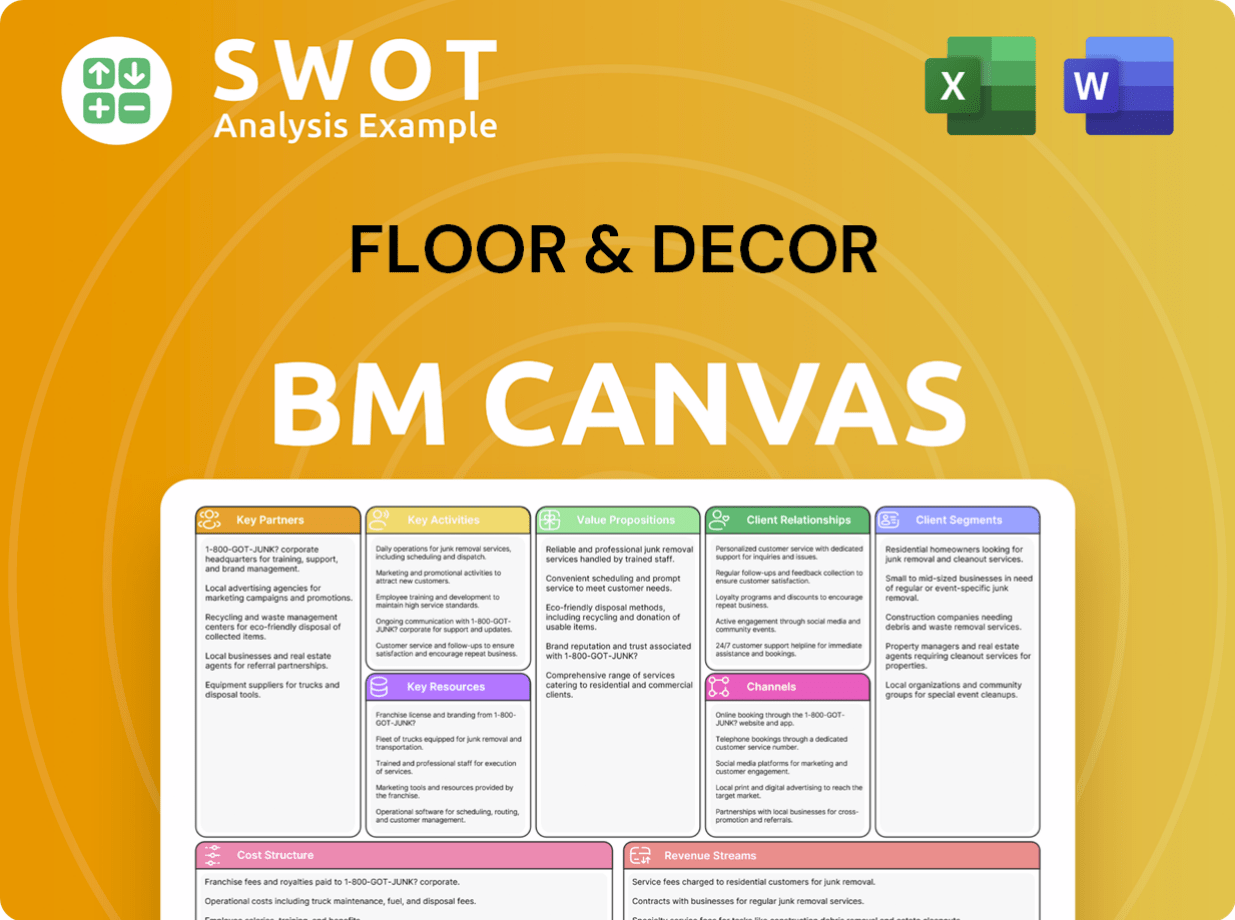
What is the Timeline of Key Events for Floor & Decor?
The Floor & Decor's history is marked by significant growth and strategic shifts, starting with its founding in 2000. The company's milestones include acquisitions, public listing, and expansion of store locations, reflecting its evolution in the flooring industry. The company's initial business model has been adapted over time to meet changing market demands.
| Year | Key Event |
|---|---|
| 2000 | Founded by George Vincent West in Atlanta, Georgia. |
| 2003 | Acquired by private equity firms Saugatuck Capital and Najeti Ventures. |
| Early 2006 | Operated 13 stores across the southern U.S. |
| November 2010 | Acquired by Ares Management and Freeman Spogli & Co., operating 25 stores. |
| 2012 | Thomas Taylor appointed CEO. |
| 2017 | Went public, listing on the NYSE as FND, operating 65 warehouse stores. |
| February 2018 | Opened a new 1.4 million-square-foot distribution center in Bloomingdale, Georgia. |
| 2020 | Net sales reached $2.4 billion. |
| 2021 | Sales grew to $3.4 billion. |
| 2022 | Sales reached $4.3 billion. |
| December 2023 | Operated 221 warehouse stores and five design studios. |
| 2024 | Net sales approximately $4.5 billion; operates 251 warehouse-format stores and five design studios across 38 states. |
| March 2025 | Brad Paulson appointed as the new president. |
Floor & Decor aims to expand its presence with a long-term goal of reaching 500 stores across the U.S. For fiscal year 2025, the company plans to open 25 new warehouse stores.
The projected capital expenditure for fiscal year 2025 is between $330-$400 million, with $200-$245 million allocated for new store openings. The company anticipates fiscal 2025 total sales to be between $4.740 billion and $4.900 billion.
The company is focused on investing in its Pro customer segment and expanding into commercial surfaces, a $16 billion domestic addressable market. The company's strategy includes continued investment in its Pro customer segment and further expansion into commercial surfaces.
Analysts predict revenue growth to accelerate to 8.4% in 2025 and 16% in 2026. This growth is driven by the shift from carpet to hard surface flooring and the aging U.S. housing stock. The company's competitive advantages in scale, selection, and availability are expected to drive market share gains.
Floor & Decor Porter's Five Forces Analysis
- Covers All 5 Competitive Forces in Detail
- Structured for Consultants, Students, and Founders
- 100% Editable in Microsoft Word & Excel
- Instant Digital Download – Use Immediately
- Compatible with Mac & PC – Fully Unlocked
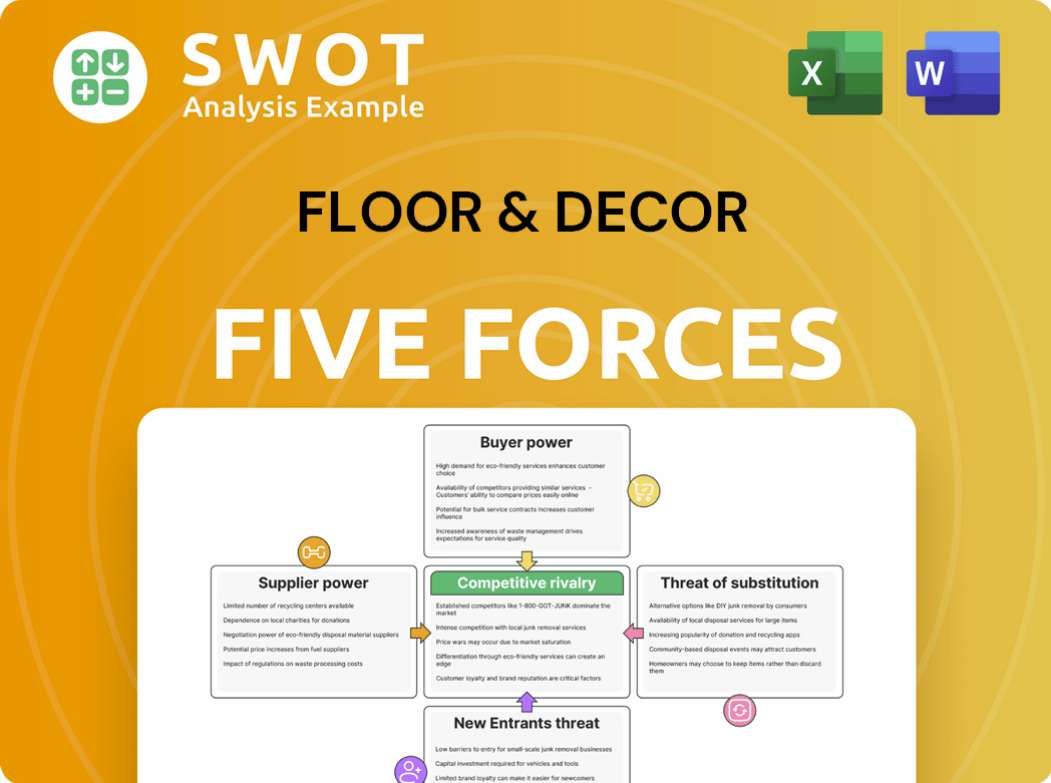
Related Blogs
- What is Competitive Landscape of Floor & Decor Company?
- What is Growth Strategy and Future Prospects of Floor & Decor Company?
- How Does Floor & Decor Company Work?
- What is Sales and Marketing Strategy of Floor & Decor Company?
- What is Brief History of Floor & Decor Company?
- Who Owns Floor & Decor Company?
- What is Customer Demographics and Target Market of Floor & Decor Company?
Disclaimer
All information, articles, and product details provided on this website are for general informational and educational purposes only. We do not claim any ownership over, nor do we intend to infringe upon, any trademarks, copyrights, logos, brand names, or other intellectual property mentioned or depicted on this site. Such intellectual property remains the property of its respective owners, and any references here are made solely for identification or informational purposes, without implying any affiliation, endorsement, or partnership.
We make no representations or warranties, express or implied, regarding the accuracy, completeness, or suitability of any content or products presented. Nothing on this website should be construed as legal, tax, investment, financial, medical, or other professional advice. In addition, no part of this site—including articles or product references—constitutes a solicitation, recommendation, endorsement, advertisement, or offer to buy or sell any securities, franchises, or other financial instruments, particularly in jurisdictions where such activity would be unlawful.
All content is of a general nature and may not address the specific circumstances of any individual or entity. It is not a substitute for professional advice or services. Any actions you take based on the information provided here are strictly at your own risk. You accept full responsibility for any decisions or outcomes arising from your use of this website and agree to release us from any liability in connection with your use of, or reliance upon, the content or products found herein.